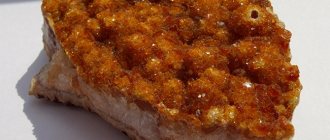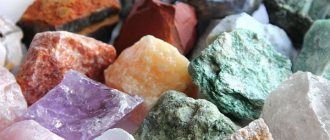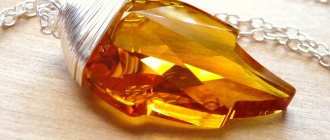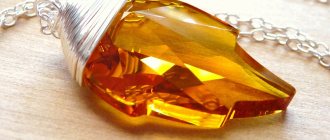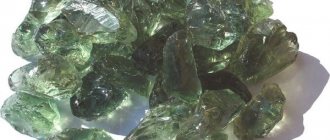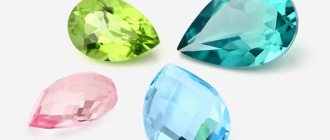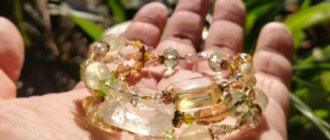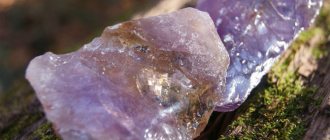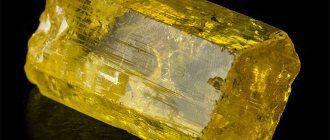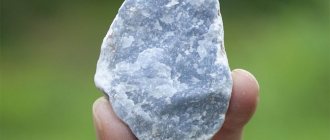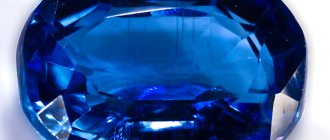Citrine is a transparent yellow stone from the quartz family, containing silicon oxide. Hardness 7, density 2.65 g/cm3. The stone has different shades - from light lemon to deep brown-orange, depending on the amount of iron impurities in its composition. When you rotate the crystal at different angles, you can see the changes in shades.
The sun stone has been known in the history of jewelry since the mid-16th century. Because of its golden tints, it is sometimes called “golden topaz.” Some citrines exhibit a beautiful optical effect in the form of bluish rays, similar to sunlit rain streams. This effect occurs due to the finest cracks enriched with gas-liquid inclusions.
The name “citrine” was given to the stone in the middle of the 18th century (citreus – lat.) Even then it adorned the crowns of the rulers of the world and served as decoration for noble gentlemen. In the 19th century, jewelry makers began to use the stone to make seals. Citrine is quite rare in nature, which is why it was previously and now obtained by firing amethyst crystals, an equally beautiful stone of lilac shades, also from the quartz family.
Sometimes there is a crystal that combines two varieties of quartz - amethyst and citrine. By subjecting amethysts to heat treatment, stones of beautiful colors are obtained. By the color of the stone you can determine whether it is real, that is, whether it is natural citrine or already burnt quartz. By their nature, citrines are transparent, pale lemon in color, and a rich palette of shades with bright colors are obtained by firing.
Be that as it may, both are beautiful and worthy of admiration. Among all the burnt ones there is a shade of deep, thick color, similar to the shade of wine, and therefore is called “Madera”. This unique stone looks very impressive in jewelry.
Citrine deposits. In Russia, citrine was found in the Urals, and Brazil is considered the richest deposit. Crystals have been found in the USA, Spain, and Madagascar.
Colors and varieties
Citrine in different shades The color scheme of true citrine tends to be lemon yellow.
In gemology, there is an established tradition of calling brownish-honey specimens “Spanish topaz” and lighter ones – “Bohemian”. Citrine shades can range from completely light to amber, although annealed former quartz gemstones usually have a rich orange-gold or honey tone. There is a rare type of stone - ametrine, a “cross” of citrine and amethyst. It is a mineral with alternating stripes of light yellow and lilac shades. It is mined mainly in Brazil as a companion rock.
Green citrine, or false emerald, has no jewelry value, since it quickly loses color in the light.
Colors and types
The name, received in 1747, comes from the Latin citrus (lemon yellow), describing its color. The color of the gem has all shades of yellow - from pale lemon to rich amber-honey. Due to ignorance, it is difficult to distinguish it from yellow topaz; in fact, it was called “Spanish topaz” until the middle of the 18th century. Citrine stone acquires a yellow color due to admixtures of aluminum, iron and silicon; shades depend on their concentration, and the types of mineral are distinguished by them.
Lemon yellow citrine
The most common type of stone found in mining. The color is bright, deep and pleasing to the eye. After cutting, a blinding shine appears with golden and reddish tints. It can easily be used to identify a natural mineral; it is impossible to fake such a color by calcination.
Pale lemon
Crystals are least common in deposits. They have a crystal-transparent structure and glassy luster, shimmer with warm tones, but in the rays of the sun they tend to discolor, becoming like a pure diamond.
Golden yellow
Jewelers conventionally call golden-yellow citrines “golden topaz.” Outwardly, they indeed resemble some varieties of this stone. It is noteworthy that only faceted samples acquire this color. This happens due to their high degree of transparency and light refraction, due to which a golden shine is achieved.
Light brown citrine
Light brown and brownish-yellow minerals are conventionally classified as “Spanish topaz”, which visually resemble them. However, jewelers can easily distinguish between citrines and topazes - the latter are less transparent, which is why they appear cloudy. In addition, topazes have greater density, hardness, and, more importantly, the ability to shimmer with all the colors of the rainbow.
Green citrines
The rarest type of stone, not often found in nature. Sometimes they are mistaken for emeralds, but this is only the first impression. Citrines have a distinct yellowish tint and are of lower clarity than crystal clear emeralds, which have a rich plant green color.
Yellow-blue stones
A rare variety of citrine, distantly related to amethysts, taking on segments of its color. This type is called ametrine - based on the combination of the names of two minerals and their characteristics. The only place where they are found is the emerald mines of Bolivia, where the discovery of ametrine is a real event.
Orange-brown, bright orange varieties are in no way related to citrine - they are burnt smoky quartz, amethyst or morion. This also applies to wine-yellow crystals made artificially from cheap Brazilian amethysts. Too rich a color is the first sign of a fake.
Imitations of citrine, false citrine
Citrine.
Brazil Most commercial citrines are treated smoky quartz or treated amethyst. The similarity is achieved by calcining smoky quartz at a temperature of 500 °C (the temperature may vary depending on the deposit and transparency of the crystal, as well as its color), after which it acquires a stable yellow, honey or orange color. Individual crystals may have a slightly greenish tint.
Some varieties of smoky quartz become yellow when heated to 300–400 °C. The maximum heating temperature for smoky quartz is 570 °C, however, with such heating there is a high probability of cracks appearing inside the crystal, which can lead to either complete or partial unsuitability for jewelry processing.
This is interesting!
It is interesting that in nature there are also natural heated citrines, which in fact are not citrines, but having a natural origin and a color suitable for classification as citrine, can be called natural citrine.
Citrine. North Ural, Russia. The height of the brush is more than 15 cm. Sample Gems Museum Photo by A.A. Evseev.
For example, in Africa there are places where amethysts come out through landslides or washed out by rivers/rains. After lying on the surface for ten years under the scorching sun, such amethysts lose their purple or violet hue and become orange.
However, such citrines are quite rare, so on the market almost all crystals with a reddish or deep orange tint are artificially heated.
All heat-treated stones have a thicker color and a noticeable reddish tint. Also, such crystals are distinguished by an opaque white structure at the base, stretching all the way to the edges of the crystal head.
Natural citrines are usually pale yellow. Citrines heated to a certain temperature do not have pleochroism, and crystals with natural colors show weak pleochroism.
Magical properties of citrine
Pendant with citrine stone
The magical power of the stone helps a person in all areas of life. It will improve your financial situation, attract good luck, and help you maintain composure in force majeure situations.
The magical properties of citrine equally reliably protect respectable people and notorious scoundrels:
- He imparts cunning, so swindlers and swindlers of all stripes consider him theirs.
- People with an exaggerated sense of justice and honesty will be disappointed.
- It pulls you out of depression, raises self-esteem, and puts your thoughts in order.
- Indispensable when thinking about decisions.
- It has the color of gold - the main material attribute of wealth. This means having a citrine crystal or druse in your wallet or cash safe. Then the money will increase, and profitable deals are guaranteed.
- This is a family stone that brings harmony and warmth to the home.
- Yellow crystal is indispensable for children. The amulet worn by the mother has a special meaning - it will protect you from troubles and help you throughout your life.
- For practitioners of magic, citrine enhances intuition and increases strength.
- In China, it is the carrier of male Yang energy.
Talismans, amulets, amulets
Pendant with untreated citrine
The magical properties of the stone have been known since antiquity. The ancient Romans considered it an attribute of orators, in Russia - merchants, since it allegedly helped to make capital. The Indians used it as an amulet against snakes.
Citrine stone is still used as a talisman today:
- politicians - to be convincing when speaking;
- gambling people - so that Fortune is nearby and peace of mind is maintained;
- bohemian personalities - to attract inspiration;
- people whose main tool is their hands - jewelers, surgeons, engravers, restorers, hand-made artists;
- sales agents, brokers, brokers - to benefit from information or personal connections;
- natures with a subtle mental organization - stones are suitable for becoming more tempered and believing in yourself;
- businessmen take bright orange copies with them to negotiations or signing contracts. A business woman needs a pendant, a man needs a signet with citrine.
Paranormal researchers are confident that the mineral, by creating an impenetrable aura around the owner, protects against external negativity. The main thing is that the crystal affects the solar plexus, balancing and improving the mental and physical state of a person.
Magic properties
The magic of citrine works in several directions:
- Monetary “Merchant’s Stone” is one of the ancient names of the mineral. Esotericists recommend this talisman to trade representatives, as well as to those who want to increase their wealth. To do this, the stone is placed in a wallet, cash register, or along with cash savings.
- Sociable. Charisma, confidence, charm - these qualities are observed in owners of the mineral. The gift of persuasion and victory in disputes are useful for people of relevant professions - managers, brokers, businessmen.
- Creative. Citrine is an assistant to creative people, as well as to those people who do delicate work - jewelers, watchmakers, surgeons.
- Spatial. The stone is known as a purifier of any space from external negativity. Therefore, the talisman works as a talisman against family discord, collective strife, and is suitable for meditation. At the same time, the amulet dissipates negative energy instead of absorbing it. So citrine does not require energetic cleansing.
It is believed that the yellow mineral makes the owner happier and also helps to remember dreams, while eliminating nightmares. But any medal has two sides - the stone is indiscriminate in its owners. The nugget gives the gift of communication and persuasion to everyone, including swindlers who, with the help of a talisman, can easily deceive a naive person.
Medicinal properties
Owning jewelry with this stone supports:
- heart;
- full secretion of insulin;
- optimal functioning of the pancreas;
- liver and spleen function;
- digestive system;
- circulatory system;
- thyroid function, etc.
The mineral enhances a person’s own capabilities, strengthening the immune system, removing toxins and eliminating infections. It is believed that it increases the regenerative powers of the body during illness, reduces cholesterol levels in the blood, prevents dizziness, relieves migraines, fights dry skin and varicose veins, maintains stable weight and good vision.
Just like many other amulets, it helps women in labor and strengthens the nervous system. Insomnia is not a problem for the owner of such jewelry; citrine will help you fall asleep and ensure a restful and sound sleep.
There are many known recipes for using the stone, but the elixir is most often used. The method of preparing it is simple: the mineral is simply kept in water for 12 hours, then lotions are made with this water to cure acne and ulcers. If the owner of the stone is in a depressed state, then the elixir can be sprinkled around the apartment, and the citrine itself can be placed on the body in the solar plexus area. It is comfortable to lie on your back and breathe evenly and calmly for 20 minutes.
Important!
We are talking only about natural minerals. Data on the healing properties of the stone have not been scientifically confirmed, although there are many studies, but this information is not a substitute for consulting a doctor.
Products and jewelry with citrine
Jewelry with citrine
Simple processing, physical and optical characteristics determine the use of citrine in jewelry.
Citrine is a valuable collectible and jewelry mineral, and is used to make all kinds of jewelry and expensive accessories. Tiaras, beads, pendants and brooches are made from it; earrings, bracelets, various necklaces and rings are encrusted with it.
For clear crystals, diamond cut is used, and cloudy versions are most aesthetically pleasing in a flat design.
Modern technologies make it possible to realize the most unusual design ideas using citrine. Jewelry becomes even more exquisite if it is complemented with gold.
More transparent versions are usually used in the design of earrings, pendants, brooches and rings, while duller examples adorn necklaces, bracelets and all kinds of tiaras.
When purchasing products with this and other stones, be sure to familiarize yourself with the effect of natural material on your physical and psychological health. This will help not only avoid negative consequences, but also increase your vitality, strengthen your self-confidence and achieve incredible heights.
Citrine (cut). Exhibition-fair World of Stone St. Petersburg 2014
Citrine - magical and healing properties of the stone
The stone has a very positive influence
, because its honey color attracts the eye and warms the soul, you want to look at it and look at it. Citrine gives the owner clarity of thought, feelings of joy, and inner harmony. He is known both as a healer of diseases and simply as a person’s assistant in mental activity. For a long time, people have used crystals as amulets, hoping for good luck and patronage in financial well-being. Medieval doctors advised especially nervous ladies to wear a citrine ring at night to calm down and sleep soundly.
Signet rings were made from citrine. Speakers decorated their clothes with crystals. They wore beads, necklaces, and bracelets, hoping to receive from the stone the solar energy that it had absorbed. And today, lithotherapists recommend wearing jewelry with citrine to improve brain function and, in general, as a preventive measure for any disease. Astrologers recommend citrine to those who are under the protection of Mercury, and for Gemini they consider it a faithful assistant.
Wonderful Finds
Citrine "Malaga" - the largest stone is named after the city in which it was exhibited at the exhibition. The stone reaches 20,200 carats, with dimensions 25x25x15. Another crystal weighing 2258 carats is located at Smithsonian University.
Citrine cost
Citrine.
Trilliant. 5047 carats This is a jewelry gemstone and a mineral sought after by collectors.
Natural crystals are expensive, so they often offer examples of fired smoky quartz, the price of which is more affordable. Visually they are indistinguishable from natural ones. Natural citrine costs $8-10 per carat.
Madeira specimens have the highest price - they have increased light and heat resistance.
How much a stone costs is influenced by:
- weight;
- degree of purity;
- color;
- saturation.
The highest price is for large stones of absolute purity, darkened areas or matte inclusions reduce it.
Pure transparent citrine crystal is given a brilliant cut. For cloudy or cracked stones, use a flat or cabochon.
How to recognize a fake
Citrine.
Ural, Russia. Natural citrine is characterized by a pale color, impurities, and small cracks. Due to its rarity, the original is counterfeited by heating amethyst and smoky quartz to temperatures ranging from 500 degrees. They are easy to distinguish by their bright, rich color and red tint. Quartz placers mined on the surface do not require firing, since the minerals burn out under sunlight and become similar to natural citrines.
Yellow crystals are distinguished from fake crystals by pleochroism, when shades change under the same lighting under different viewing angles. If the color is stable, then it is not citrine. If they try to pass off counterfeit glass as an original, they check for the presence of dichroism - a splitting of the beam passing through the crystal.
Plastic products are lightweight, heat up quickly in the hand, and scratches from the needle point remain on the surface. In addition, the imitation is smooth, even, without defects. To avoid becoming a victim of scammers, buy jewelry with lemon inserts in jewelry stores, where the gems are accompanied by a certificate of conformity.
How to care for stone
Of course, only quartz that is kept clean and properly looked after can look beautiful. The first thing that needs to be said is that you need to store a product made from citrine stone strictly in a box, without throwing it on the surface. The fact is that with frequent and prolonged contact of jewelry with sunlight and air, it can lose its luster and brightness.
If there is a need for cleaning, the product can be washed, but to do this you need to use water at room temperature, strictly without soap. After the procedure with water, you need to thoroughly wipe the jewelry with a moisture-absorbing cloth. Do not leave the jewelry wet under any circumstances; this will negatively affect the shine and quality of the stone, shortening the life of the citrine. Special products for the care of precious and semi-precious stones also help.
Citrine jewelry
Citrine is used in rings, bracelets, earrings, and necklaces. A piece of jewelry with citrine framed in gold looks especially luxurious.
. The combination of noble metal and bright golden crystal complement each other in decoration. Gold and citrine shimmer and sparkle with golden rays, reflected in the edges of the stone and in the ideal surface of the noble metal.
Since ancient times, icons, stained glass windows and clothing have been decorated with citrine inserts. Jewelry with citrines is still a favorite. In jewelry technology, crystal is not difficult to process; moreover, it harmonizes perfectly with other precious stones; jewelry with diamonds framed in gold looks especially impressive.
The cut of citrine is selected based on the transparency of the stone. If the crystal does not contain internal cracks or defects, then a diamond cut is used. In this case, rings, earrings, and pendants are decorated with crystals. If there are any defects, it is cut into a cabochon. These crystals are used to make necklaces and bracelets. Citrine requires careful handling. It must be protected from mechanical and thermal influences.
Citrine is a very popular stone. After all, both young and adult women can wear jewelry with it. It will not go unnoticed on a sunny day or at an evening event; citrine is appropriate at any time of the year. The stone will decorate your image, give you a good mood, and make you charming.
Who is suitable for citrine according to the horoscope?
The meaning of citrine for a person, depending on the sign:
- Aries. Citrine will help this sign increase its already powerful potential, so it must be worn extremely carefully. Excessive activity, fearlessness and increased self-esteem, fueled by the magic of citrine, are fraught with various consequences. For too bright Aries, citrine is recommended to be worn from time to time. Correctly wearing amulets with this mineral will help you achieve success and develop at the fastest possible pace.
- Calf. Citrine will help this sign develop a craving for creativity, abstract thinking and strengthen organizational abilities. It will be easier for Taurus to develop an optimistic outlook on the future, reduce their lack of self-discipline and maximize their capabilities.
- Twins. In a close “friendship” with citrine, only those Geminis who serve high goals and honor the laws of justice will be happy. The energy of the crystal is very pure, therefore it “loves” people only with a pure soul. Citrine helps strengthen their will and develop self-esteem.
- The energy capabilities of the “sun” stone activate the vital and psychological forces of Cancer. Its energy and magical properties will add tolerance and generosity to the sign, help strengthen love unions, and become useful companions in achieving large-scale goals.
- A lion. The fiery energy of the stone is very consistent with the obstinate and selfish Leo, and therefore can enhance both the positive and negative traits of the sign. For Leo, known in wide circles as an organizer and leader, citrine will be a worthy helper, inspirer and protector. This fire sign will certainly appreciate the luck and social recognition the stone brings.
- Virgo. For people of this sign who want to increase their material well-being, citrine will be most useful. Organizational abilities born from the magic of the stone will be productive not only for Virgos, but also for those around them. However, it can bring disappointment to honest, vulnerable and fair natures, endowing them with cunning and cunning. Women of this sign will be able to maximize their sexuality, charm and beauty.
- Scales. For Libra, the stone will help improve strong qualities, overcome uncertainty, overcome all obstacles on the career ladder, establish new connections and achieve success. However, the “friendship” of the sign with the stone should be moderate, so as not to induce unhealthy excitement and vanity.
- Scorpion. One of the signs for which the energy of a natural crystal is completely contraindicated. Citrine suppresses the fiery nature of the sign, so astrologers do not advise storing this stone in the house, and especially as a talisman or amulet near the body.
- Sagittarius. The magical energy of citrine is in complete harmony with the Sagittarius temperament. The stone will improve physical and psychological well-being, enhance the charm of its owner, increase income and increase the body's resistance.
- Capricorn. By their nature, people of this sign are able to achieve a lot on their own, but supported by the “solar” energy of the stone, strong natures will be able to do the impossible. The stone will guide you on the right path, indicate the best methods for achieving your goal and give you all the strength to overcome obstacles, as well as instill faith and ignite a spark.
- Aquarius. Amulets with citrine will help to bring down the mysterious nature of Aquarius, who is attracted by everything unknown and magical. Correctly directed energy of the stone will maximally contribute to balance and the realization of the unrealizable plans of the sign. This tandem is capable of accomplishing the impossible if Aquarius understands in time how to use the power of the crystal. Otherwise, it is better to abandon the magic of the stone until better times.
- Fish. The slippery nature of the sign is capable of being cunning and achieving what it wants in any way, so incorrect use of citrine energy can lead to unexpected results. For everything to work out, you need to have pure thoughts, faith in goodness and in yourself, and then this benefactor will help you reach incredible heights and become a powerful source of life potential.
In any case, for each of the signs (with the exception of some), citrine has only a positive effect and helps to achieve what you want. Due to the powerful power for some signs, the use of amulets and talismans with this crystal should be careful and moderate.
Products with citrine
Jewelry made from natural gems is highly valued and has amazing beauty. This rare variety of quartz, which is base by definition, is in some cases more expensive than Grade I gemstones. Exquisite jewelry is made from individual crystals: rings, earrings, pendants, necklaces and brooches; the citrine druse takes pride of place in the collection of minerals.
A gold frame suits the gem best, harmoniously matching the color.
In terms of compatibility with other stones, it has no equal: it looks equally good with everyone. Products with natural citrines will be the best gift for women, as they favorably highlight any color type of appearance. Rosaries, beads, amulets and talismans are made from orange, light brown and other not very valuable varieties.
Citrine is an amazing mineral that attracts attention with both its beauty and rarity, which adds value and meaning to it. Its unique properties, both magical and healing, are noted, and it is compatible with most zodiac signs and other stones.
Compatibility with other minerals
Citrine is a stone of the air element; it is protected by the Sun. Based on this, combinations of gems are selected.
Compatibility table of citrine with other gems:
| Perfect compatibility | Neutral attitude (Earth element) | Antagonists - stones of the Water element |
| Rhinestone | Labrador | Alexandrite |
| Amethyst | Agate | Pearl |
| Chrysolite | Turquoise | Sapphire |
| Amazonite | Onyx | Moon rock |
| Topaz | Nephritis | Emerald |
| Demantoid | Lapis lazuli | Opal |
| Beryl | Malachite | Aquamarine |
| Tourmaline | Green Jasper | Coral |
| Uvarovite | Morion |
Compatibility with other stones
“Spanish Topaz” belongs to the element of Air.
Spanish topaz
It works best in conjunction with other gems of its native element, including:
- amethyst;
- rock crystal and all other types of quartz, except morion;
- uvarovite;
- demantoid;
- blue chalcedony;
- amazonite;
- tourmaline;
- true topaz;
- golden beryl;
- fluorite;
- sparrow;
- chrysoprase.
In combination with Fire stones, it can enhance the power of the latter, but only if it is not a “noble duet” - a diamond with a ruby. Of the fire citrines, it is compatible only with less valuable garnets of all types, as well as with pyrite and heliolite. It is also good friends with stones that have a dual elemental affiliation - both Air and Fire. These are carnelian, hematite, noble spinel, charoite and amber.
He behaves neutrally with the stones of the Earth - as if they don’t exist at all, they will also “work” on their own. Among them:
- jasper;
- jade;
- chalcedony (except blue);
- agates;
- turquoise;
- malachite;
- crocodile;
- morion;
- obsidian;
- cacholong;
- Labrador;
- nephritis.
Ring with citrine Citrine
“doesn’t like” only its proximity to Water minerals - Air and Water combined create a storm. Since citrine does not have its own energy, it will not actively influence Water stones, but these stones themselves may not like such company. The worst people to treat citrine are:
- emerald;
- sapphire;
- opal;
- true topaz;
- pearl;
- alexandrite;
- chrysolite.
You should not wear it with aventurine, melanite or zircon, which are identified with the Earth + Water connection.
